What are the Codes and Conventions?
- Mise-en-scene- Everything in the scene/frame props, costumes, setting, lighting, performance, facial expression and make up.
- Narrative/Structure-Story
- Setting
- Character
- Theme- Ideas/Morals explored
- Sound- Diegetic,in the world of the show.Non Diegetic, not in the world of the show.
- Cinematography- Camerawork.
Textual Analysis is the process of breaking down a text into its various elements and studying them to analyse how meaning is created. When analysing moving image media (such as film or television) we must examine the following areas:
Camerawork (shots,angles,movements)
Editing (how shots have been put together)
Sound (both diegetic and non diegect)
Special Effects (if there are any)
Mise-en-scene (costume,make up, facial expression,props, setting, performance)
Wide Shot/ Establishing Short
Long Shot
3/4 Shot
Mid Shot
Medium Close up
Close Up
Big Close up
Extreme Close up
Low- Camera looking up at subject,making it look bigger.
Canted- Camera is tilted to make subject look slanted.
High- Cameras looking down on subject making it look smaller.
Worms eye- Extreme low angle, camera very low looking up
Eye level -Camera is pointed directly at subject
Birds eye/Aerial- extreme high angle,looking straight down.
Point of view shot
- Camera shoots from a character point of view.
Over the shoulder shot
-Camera shoot over a character shoulder.
Top
Crab -The camera move sideways,like a crab does.
Pan -The camera stays in the same spot but pivots left or right.
Side
Tilt -The camera stays in the same spot but tilts up or down.
Dolly- Also known as tracking, the camera moves backwards or forwards.




No comments:
Post a Comment